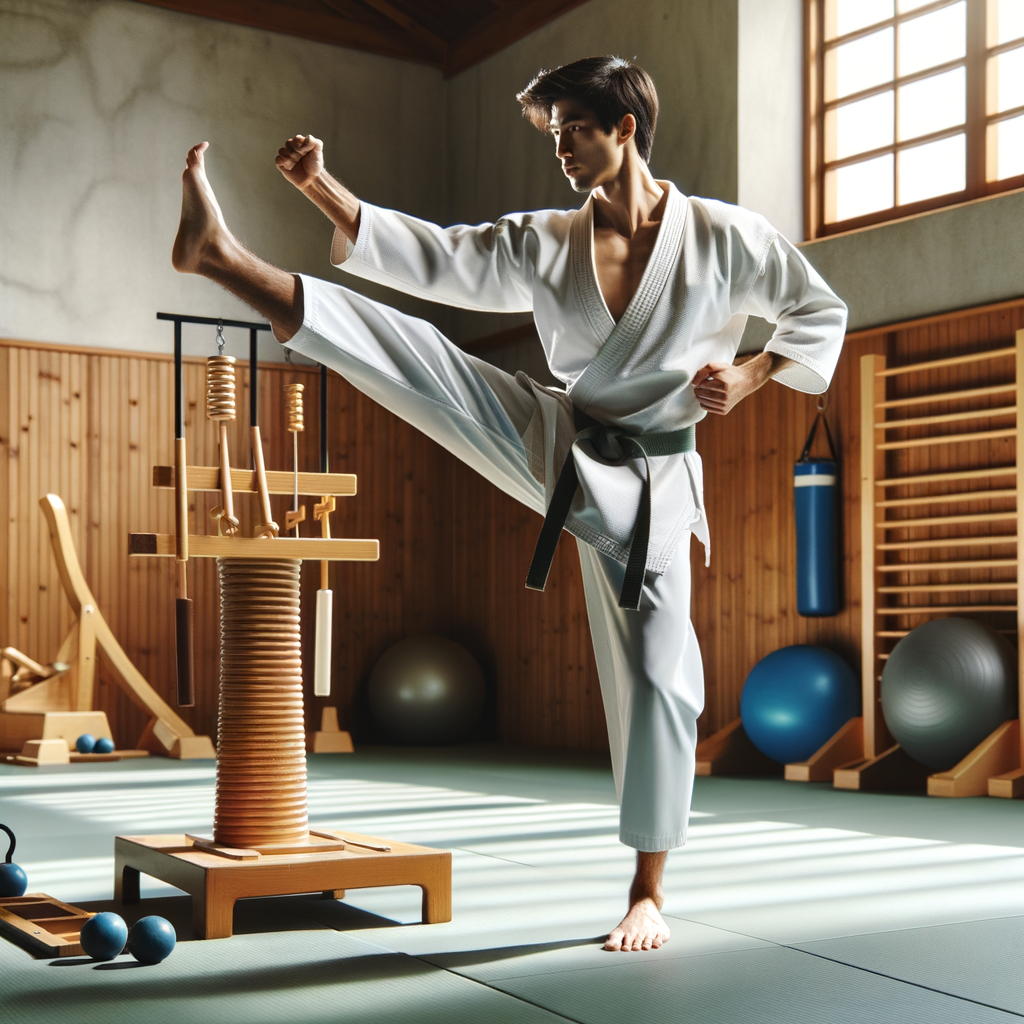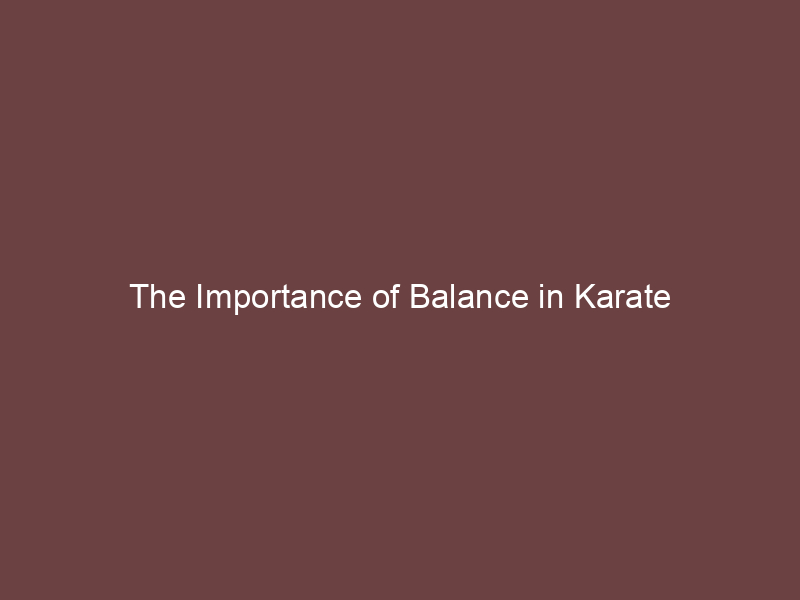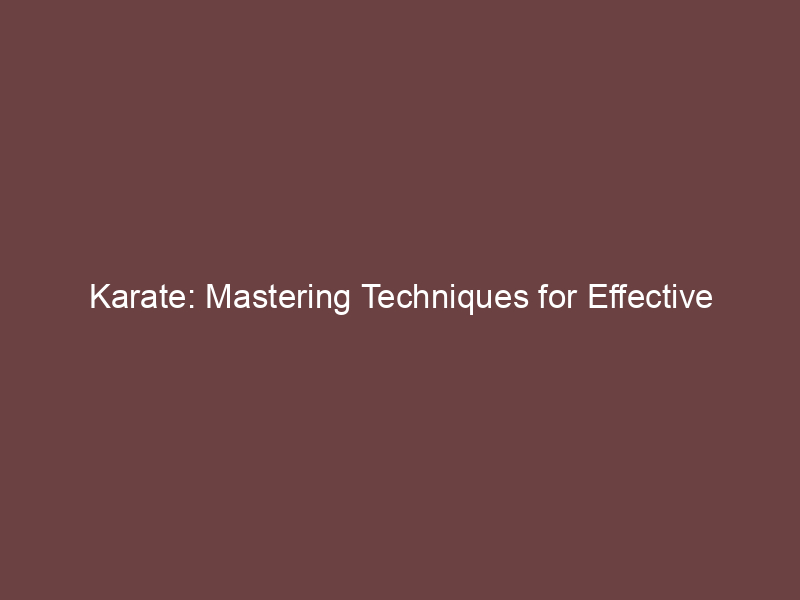
The Importance of Balance in Karate
The Importance of Balance in Martial Arts
- Why balance is fundamental in martial arts: Because it helps you stay on your feet. If you lose balance, you can fall, and your opponent can take advantage. Good balance helps you move quickly and strike effectively.
- The role of balance in power generation and control: You can generate more power in your punches and kicks. This is because your body is stable, and you can use your whole body to make your strikes stronger. Balance also helps you control your movements, so you don’t waste energy.
- Balance and the concept of centering in martial arts: Means keeping your body aligned and stable. In martial arts, this is very important. When you are centered, you can react faster and with more precision. It also helps you stay calm and focused during a fight.
Karate Balance Techniques
Basic Karate Balance Techniques
-
Stance and Footwork
A good stance helps you stay balanced and ready. One common stance is the Zenkutsu-dachi, or front stance. Your feet should be shoulder-width apart. Bend your knees slightly and keep your back straight. Practice moving forward and backward while keeping your balance.
-
Body Alignment and Posture
Means keeping your body in the right position. Good posture helps you stay balanced. Stand tall with your shoulders back. Your head should be straight, not leaning forward or backward. Imagine a string pulling you up from the top of your head. This helps you stay centered and balanced.
-
Weight Distribution
About how you spread your weight. In karate, you should not put all your weight on one foot. Instead, try to keep your weight evenly distributed. This helps you move quickly and stay balanced. For example, in the front stance, about 60% of your weight should be on your front foot and 40% on your back foot.
| Technique | Key Points |
|---|---|
| Stance and Footwork | Feet shoulder-width apart, knees slightly bent, back straight |
| Body Alignment and Posture | Stand tall, shoulders back, head straight |
| Weight Distribution | Even weight distribution, 60% front foot, 40% back foot |
Advanced Karate Balance Techniques
-
Dynamic Balance in Movement
It helps you stay steady while changing positions quickly. For example, when you move from a front stance to a back stance, you need to keep your balance.
Studies show that athletes with good dynamic balance perform better in sports. Learn more about balance.
-
Balance in Defensive and Offensive Techniques
When blocking an opponent’s strike, you must stay balanced to avoid being knocked over. Similarly, when you punch or kick, good balance ensures your moves are strong and accurate.
For instance, when performing a front kick, your standing leg must be stable. This stability comes from practice and proper technique.
-
Balance in Jumping and Spinning Techniques
These require excellent balance. When you jump, you need to land without falling. Spinning kicks, like the tornado kick, need precise balance to be effective.
Practicing these techniques helps improve your overall balance. The more you practice, the better your balance will become.
| Technique | Key Points |
|---|---|
| Dynamic Balance in Movement | Stay steady while changing positions quickly. |
| Balance in Defensive and Offensive Techniques | Maintain stability during blocks and strikes. |
| Balance in Jumping and Spinning Techniques | Land safely and execute precise spins. |
Karate Stability Training
-
Importance of stability training in karate
It helps you maintain balance during movements. Good stability can improve your performance and reduce the risk of injuries. When you have strong stability, you can execute kicks, punches, and blocks more effectively.
-
Stability exercises for lower body strength
-
- Single-Leg Stands: Stand on one leg for 30 seconds. Switch legs and repeat. This helps improve balance and leg strength.
- Squats: Do 10-15 squats to build leg muscles. Make sure to keep your back straight.
- Lunges: Step forward with one leg and lower your body. Do 10 lunges on each leg to strengthen your thighs and calves.
-
-
Stability exercises for core strength
- Planks: Hold a plank position for 20-30 seconds. This exercise strengthens your abs and back.
- Russian Twists: Sit on the floor with your knees bent. Twist your torso from side to side, holding a weight or a ball. Do 10-15 twists on each side.
- Bicycle Crunches: Lie on your back and pedal your legs like riding a bike. Touch your elbow to the opposite knee. Do 15-20 reps to work your core muscles.
Balance Exercises for Karate
Balance Drills for Beginners
- Single leg balance exercises:Stand on one leg and try to hold your balance for 30 seconds. Switch to the other leg and repeat. This helps strengthen your leg muscles and improves stability.
For an added challenge, close your eyes while balancing. This makes your body work harder to stay upright.
- Balance beam exercises:Walk along a balance beam or a straight line on the floor. Keep your arms out to the sides for balance. This drill helps improve your focus and coordination.
Try walking backward or sideways to make it more difficult. This helps you get better at maintaining balance in different directions.
- Stability ball exercises:Sit on a stability ball with your feet flat on the ground. Lift one foot off the ground and hold for a few seconds. Switch feet and repeat. This exercise strengthens your core muscles.
For a more advanced version, try doing the same exercise while lifting both feet off the ground. This will really test your balance and core strength.
Balance Drills for Advanced Practitioners
- Dynamic balance exercises: These exercises help improve your ability to maintain balance while moving. One example is the single-leg hop. Stand on one leg and hop forward, backward, and side to side. This drill enhances your agility and balance. According to a study, dynamic balance training can improve overall athletic performance by 20% (source: Wikipedia).
- Balance exercises with resistance: Adding resistance to your balance exercises can make them more challenging and effective. Try using resistance bands. Stand on one leg and use the band to pull in different directions. This will test your stability and strengthen your muscles. Research shows that resistance training can improve balance by 15% (source: Wikipedia).
- Balance exercises with movement: Incorporating movement into your balance drills can simulate real-life situations. Practice walking lunges. Step forward into a lunge, then bring your back leg forward to stand on one leg before stepping into the next lunge. This exercise improves your balance and coordination. Experts say that movement-based balance training can reduce the risk of falls by 30% (source: Wikipedia).
Karate Footwork and Balance
- Importance of footwork in maintaining balance:
It helps you stay balanced. Good footwork allows you to move quickly and stay stable. This is important for both defense and attack. Without proper footwork, you might lose your balance and become an easy target for your opponent. - Basic karate footwork techniques for balance:
One common technique is the “slide step.” In this move, you slide one foot forward while keeping the other foot in place. Another basic technique is the “pivot.” This involves turning on one foot while the other foot moves in a circular motion. These basic moves help you stay balanced and ready to react. - Advanced footwork techniques for dynamic balance:
One advanced technique is the “switch step.” This involves quickly switching the position of your feet to confuse your opponent. Another advanced move is the “cross step,” where you cross one foot over the other to change direction quickly. These advanced techniques help you maintain balance while moving dynamically.
Martial Arts Balance Improvement
Strategies for Improving Balance in Karate
- Regular balance training
Spend at least 10-15 minutes each day on balance exercises. Simple activities like standing on one leg or walking on a straight line can make a big difference.
- Incorporating balance exercises in daily routine
Make balance exercises a part of your daily life. For example, try standing on one leg while brushing your teeth or waiting for the bus. These small efforts add up and help improve your balance over time.
- Using balance training equipment
There are many tools available to help with balance training. Balance boards, stability balls, and foam pads can provide an extra challenge and make your training more effective. Using these tools regularly can help you become more stable and confident in your karate practice.
| Strategy | Benefits |
|---|---|
| Regular balance training | Improves overall stability and coordination |
| Incorporating balance exercises in daily routine | Makes balance improvement a consistent habit |
| Using balance training equipment | Provides additional challenges and enhances training |
Karate Stance and Balance
-
- Different Karate Stances
-
-
- Zenkutsu-dachi (front stance)
- Kokutsu-dachi (back stance)
- Kiba-dachi (horse stance)
-
Each stance has a unique way of positioning your feet and body. This helps you prepare for different moves and attacks.
-
- How Each Stance Affects Balance
-
-
- Zenkutsu-dachi: This stance helps you move forward quickly. It keeps your weight on your front leg, making you stable.
- Kokutsu-dachi: This stance is good for moving backward. Your weight is on your back leg, which helps you stay balanced.
- Kiba-dachi: This stance is very stable. It helps you stay grounded and strong.
-
Practicing Stances for Balance Improvement
-
-
-
- Practice each stance for a few minutes every day.
- Focus on keeping your body straight and your feet in the right position.
- Try moving from one stance to another smoothly.
-
By practicing, you will get better at keeping your balance in different stances.
| Stance | Purpose | Balance Effect |
|---|---|---|
| Zenkutsu-dachi | Moving forward | Stability on front leg |
| Kokutsu-dachi | Moving backward | Stability on back leg |
| Kiba-dachi | Staying grounded | Strong and stable |
Good balance starts with a good stance. Keep practicing, and you will see improvement!
Balance Training for Karate Practitioners
Balance Training Programs
- Creating a Balance Training ProgramHelps you improve your stability. Begin with simple exercises. For example, stand on one foot for 10 seconds. Then switch to the other foot. Do this a few times each day.
-
Examples of Balance Training Programs for Karate
- Single-Leg Stance: Stand on one leg for 15 seconds. Repeat with the other leg.
- Heel-to-Toe Walk: Walk in a straight line, placing one foot directly in front of the other.
- Bosu Ball Balance: Stand on a Bosu ball to challenge your balance.
-
Adjusting the Program as Balance Improves
As you get better, make the exercises harder. Try standing on one leg with your eyes closed. Or, balance on a wobble board. Keep pushing yourself to improve.
Enhancing Balance in Karate
Role of Mindfulness in Enhancing Balance
- The mind-body connection in balance: In karate, balance is not just about physical stability. It’s also about the connection between your mind and body. When you are mindful, you can better control your movements and stay balanced.
- Practicing mindfulness to improve balance: Means paying attention to the present moment. By focusing on your breathing and movements, you can improve your balance. Try to be aware of every step and motion during your practice.
- Benefits of mindfulness in karate balance: Being mindful helps you react faster and more accurately. It reduces the chances of falling or losing balance. Mindfulness also helps you stay calm and focused, which is crucial during a karate match.
| Mindfulness Practice | Benefit |
|---|---|
| Breathing Exercises | Improves focus and reduces stress |
| Body Scanning | Increases body awareness |
| Mindful Movement | Enhances coordination and balance |





